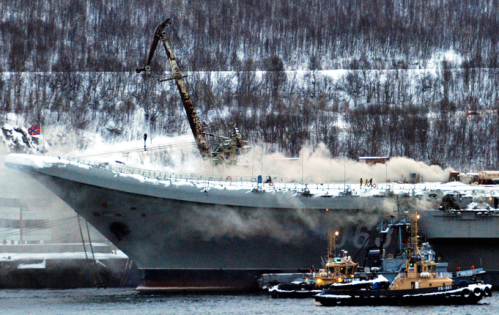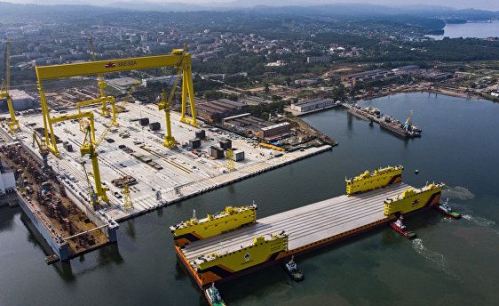President Vladimir Putin has apparently agreed to a major write-off of Russian defense industry debt. It’s a significant story not receiving much attention.

Putin with VTB chief Kostin in August 2019
The decision came in a secret presidential ukaz at the end of 2019. VTB chief Andrey Kostin broke the news in a late January interview with Rossiya 24 television at the World Economic Forum in Davos. The most coherent rendering of what Kostin said came from Interfaks-AVN:
Everything’s decided. At the end of last year the President met with all interested parties, the President’s ukaz was received, it’s true it’s secret, therefore I wouldn’t begin to comment on it. [But then he does, at least generally.]
But on the whole the problem’s solved, there is active participation of the [federal] budget and preferential restructuring on the part of leading banks is also provided, but it is so feasible, it is reasonable, it really takes into account, of course, that risk the banks took, therefore on the whole we’re satisfied with this decision. I think the government is too. So the program is being effected. I believe we won’t return to this issue again.
According to Interfaks-AVN in late December, Deputy PM and arms tsar Yuriy Borisov said measures to improve the financial state of key OPK enterprises were worked out and there would be a clearing of loans amounting to 700 billion rubles [$11 billion]. The main troubles, he indicated, were at OAK, OSK, ODK, and Roskosmos.
In early December, Borisov proposed writing off 400-450 billion of the debt and restructuring the remaining 300-350 billion for 15 years with a five-year initial payment holiday and a preferential two percent interest rate, according to a report in Rbc.ru.
Borisov and Russian bankers other than Kostin haven’t commented.
Borisov’s proposal may be the plan contained in Putin’s ukaz, but we don’t know since it’s secret. And it’s most likely secret to keep normally docile Russian citizens from learning that the government is bailing out weapons makers, not them. Russian household debt has increased steadily in recent years with little or no economic growth.
In July, Borisov said Russian defense industry’s large debt load was forcing it to “live hand to mouth, servicing financial institutions that don’t produce anything,” Interfaks-AVN reported. He indicated then that 90 percent of the debt belonged to OAK, OSK, Uralvagonzavod, Almaz-Antey, and Precision Systems (Высокоточные комплексы).
He called for writing off all or part of the debt at that time. But the biggest OPK creditors Sberbank and VTB opposed it.

Yuriy Borisov
In September, Putin directed then PM Dmitriy Medvedev to investigate problems with the profitability of defense enterprises. This came after the Military-Industrial Commission session in Izhevsk at which Putin blamed “unused capacity during a reduction in order volumes and the requirement to finance development work, the costs of which aren’t included in planning documents.” The president didn’t say anything about contract prices being too low or funding lost to waste or corruption.
Novaya gazeta reported in July that 700 billion rubles represents non-performing defense industry loans. Total OPK indebtedness, however, is 2.3 trillion rubles ($36 billion). A write-off of 700 billion rubles (or part of this amount) would be a significant hit to the working capital of major Russian banks (and OPK creditors).
Borisov said corporations and enterprises were making only interest payments on the most troubled loans, according to Novgaz. Experts told the paper that more than half of the OPK’s profits are going to debt service leaving most producers with net profits of only 3-4 percent or even losses. Defense enterprises say they are frequently paying 22-23 percent on loans accumulated over many years. Meanwhile, the Russian banking sector is earning record profits.
Based on the recent history of OPK debts, Novgaz concluded the most likely scenario is partial write-off, partial restructuring, and recapitalization of affected banks by the Finance Ministry. Promsvyazbank (PSB) — bankrupt and nationalized in early 2018 — is also being turned into a specialized bank for handling state defense orders and problem loans to the OPK. PSB might insulate healthy parts of the Russian banking sector from bad OPK debt, and possibly from U.S. economic sanctions.
Defense producers say price formation — agreement with the MOD on contract prices — remains a substantial problem, according to the Novgaz report. Its source said:
Everyone is right — both the customer can’t pay a lot, and the contractor can’t operate at a loss. But there’s no arbiter for a compromise, and the customer is always stronger.
This OPK debt write-off is pretty much like earlier ones. It may take care of the most immediate and acute symptoms but it won’t cure the causes of the ailment, including price formation, theft, and cumbersome rules about handling GOZ funds.











